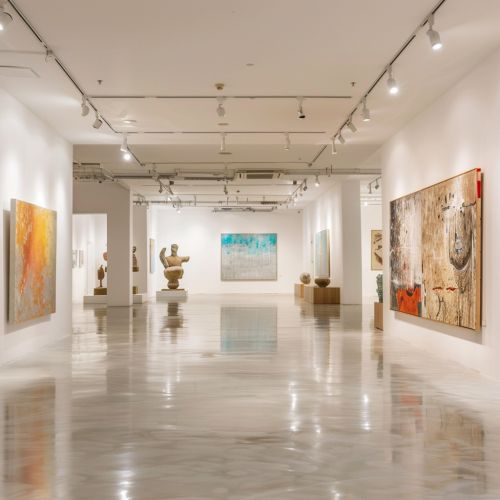Solo Exhibition
Definition
A solo exhibition, also known as a one-man show or one-woman show, is an exhibition in art museums, commercial art galleries, or other types of art spaces that feature the work of a single artist. The exhibition may showcase works in a variety of media, including painting, sculpture, photography, video, and installation art.
History
The concept of a solo exhibition has its roots in the 18th century, when the Royal Academy in London began to allow artists to organize their own exhibitions. These early solo exhibitions were often held in the artist's studio or home, and were seen as a way for the artist to gain recognition and sell their work.
In the 19th century, the solo exhibition became more common, with artists such as J.M.W. Turner and Claude Monet holding their own shows. These exhibitions were often seen as a way for the artist to assert their independence from the established art institutions of the time.
In the 20th century, the solo exhibition became a standard feature of the art world, with major museums and galleries regularly hosting shows dedicated to the work of a single artist. These exhibitions often serve as retrospectives, showcasing the artist's work over a period of years or even decades.


Purpose and Significance
A solo exhibition serves several purposes. First, it allows the artist to present a cohesive body of work. This can be particularly important for artists who work in series or whose work explores a particular theme or concept. A solo exhibition allows these artists to show the full range of their work and to demonstrate the development of their ideas over time.
Second, a solo exhibition can serve as a significant milestone in an artist's career. It can signal that the artist has achieved a certain level of recognition and success, and can provide a platform for the artist to gain further exposure and acclaim.
Finally, a solo exhibition can provide an opportunity for the artist to sell their work. While this is not the primary purpose of a solo exhibition, it can be an important aspect, particularly for artists who are not yet well-known or who are struggling financially.
Planning and Organization
Organizing a solo exhibition can be a complex and time-consuming process. It typically involves selecting the works to be exhibited, arranging for the transportation and installation of the works, designing the exhibition layout, and planning any associated events, such as opening receptions or artist talks.
The artist may work closely with a curator or gallery director to plan the exhibition. The curator or director will often play a key role in selecting the works to be included in the exhibition and in designing the layout of the exhibition. They may also assist with the logistical aspects of the exhibition, such as arranging for the transportation and installation of the works.
In some cases, the artist may also work with a publicist or marketing team to promote the exhibition. This can involve creating press releases, arranging for media coverage, and organizing promotional events.
Challenges
While a solo exhibition can be a significant achievement for an artist, it can also present a number of challenges. One of the primary challenges is the financial cost of organizing the exhibition. This can include the cost of transporting and installing the works, the cost of producing a catalogue or other promotional materials, and the cost of hosting any associated events.
Another challenge is the pressure to produce a cohesive and compelling body of work. This can be particularly challenging for artists who work in a variety of media or whose work does not easily fit into a single theme or concept.
Finally, a solo exhibition can be a significant time commitment for the artist. In addition to the time spent creating the works to be exhibited, the artist may also need to spend a significant amount of time on the logistical aspects of the exhibition, such as arranging for the transportation and installation of the works and planning any associated events.
Impact on Artist's Career
A successful solo exhibition can have a significant impact on an artist's career. It can provide the artist with increased exposure and recognition, and can lead to opportunities for further exhibitions, commissions, or sales. It can also provide the artist with a sense of validation and accomplishment.
However, a poorly received or unsuccessful solo exhibition can also have a negative impact on an artist's career. It can lead to negative reviews or a lack of interest from collectors or curators, and can potentially damage the artist's reputation.
